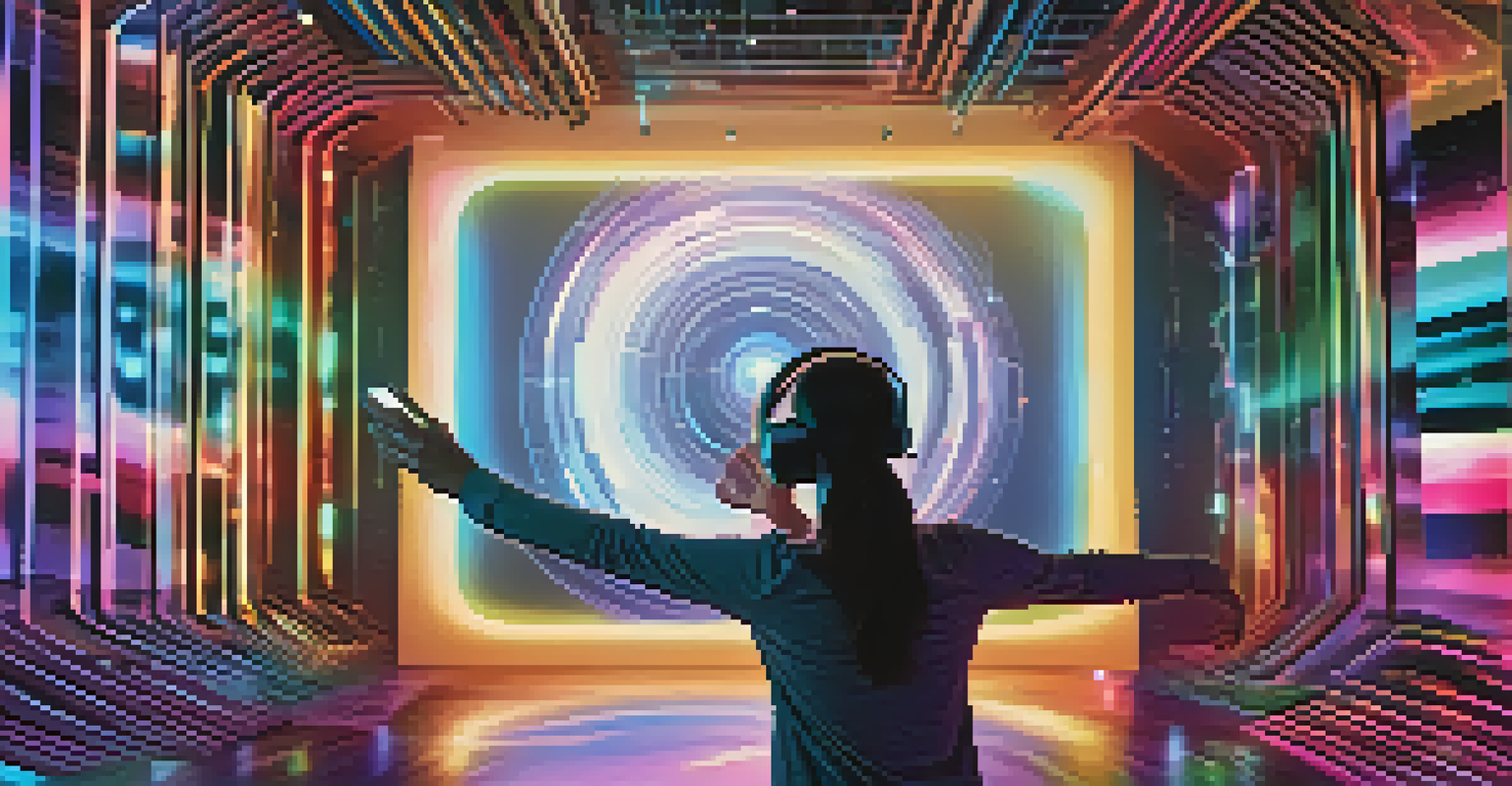The Role of Sound Design in Virtual Reality Experiences

Understanding the Basics of Sound Design in VR
Sound design in virtual reality (VR) is the art of creating audio elements that enhance the immersive experience. It goes beyond just background music; it includes all the sounds you hear in a virtual environment, like footsteps, environmental sounds, and even subtle audio cues. The goal is to make the virtual world feel as real and engaging as possible, drawing users deeper into the experience.
Sound is the universal language of mankind.
To illustrate, think about how a crackling fire adds warmth and ambiance to a scene. Without sound, that same scene would feel flat and uninviting. Sound design fills the gaps, creating a rich auditory tapestry that complements the visual elements and helps convey emotions or actions occurring within the VR space.
As users navigate these environments, the sounds they encounter respond to their movements and interactions, heightening the sense of presence. This dynamic relationship between action and sound is crucial for creating a truly immersive experience that keeps users engaged and invested in the virtual world.
Creating Immersive Environments with Spatial Audio
Spatial audio is a key component in sound design for VR, allowing users to perceive sound in a three-dimensional space. This technology simulates how we naturally hear sounds in the real world, creating a more authentic experience. For example, if a character whispers from behind you, spatial audio allows you to hear it as though it’s coming from that direction, enhancing the realism of the interaction.

By using techniques like binaural recording, sound designers can craft audio experiences that mimic how our ears pick up sound waves. This adds depth to the audio landscape, allowing users to detect the source and distance of sounds, which is essential in a VR setting. A well-executed spatial audio setup can make the difference between a good VR experience and a truly unforgettable one.
Sound Design Enhances Immersion
Effective sound design in VR creates a rich auditory environment that draws users deeper into the experience.
The ability to localize sound not only enhances immersion but also aids in gameplay. For instance, players can react to audio cues from enemies or environmental changes, making them feel more connected and responsive to the virtual world. Essentially, spatial audio transforms how users interact with VR, turning passive observation into active participation.
Emotional Resonance through Sound Design
Sound design plays a pivotal role in evoking emotions within virtual reality experiences. Music, sound effects, and ambient noise can all influence how users feel about a scene or narrative. For instance, a suspenseful score can heighten tension during a thrilling moment, while serene sounds can evoke feelings of peace and tranquility in a calming environment.
The only thing better than a good story is a good story with good sound.
Consider a horror VR game: the sound of distant footsteps or eerie whispers can create an overwhelming sense of dread. This emotional manipulation through sound is a powerful tool that can make users feel more connected to the narrative or characters, enhancing their overall experience. When sound is used effectively, it can lead to memorable moments that linger long after the headset is removed.
Furthermore, sound design can also serve to guide users emotionally through a story, signaling transitions between tension and relief. By carefully orchestrating audio elements, sound designers can craft a journey that resonates with users, making their virtual experience feel personal and impactful.
The Role of Sound in Interaction and Feedback
In virtual reality, sound serves as a crucial feedback mechanism for user interactions. When a user performs an action, such as picking up an object or completing a task, corresponding sounds signal that the action was successful. This auditory feedback is essential for creating a sense of agency, allowing users to feel that their actions matter within the environment.
For example, the satisfying sound of a door creaking open or the clink of coins collected adds a layer of satisfaction and reward. These sound cues not only enhance the realism of the interaction but also keep users engaged and motivated to explore further. The right sounds can turn mundane tasks into exciting actions, making the overall experience more enjoyable.
Spatial Audio Creates Realism
Spatial audio allows users to perceive sound in three dimensions, enhancing the authenticity of interactions in virtual reality.
Moreover, sound can also act as a guide, helping users navigate through complex environments. When users hear a sound indicating they are near an object of interest, it prompts them to pay attention, enhancing exploration and interaction. This dynamic use of audio ensures that the virtual world remains captivating and encourages ongoing user engagement.
Challenges in Sound Design for VR
While sound design is vital for enriching virtual reality experiences, it comes with its own set of challenges. One major hurdle is the technical limitations of sound playback systems and hardware. Not all devices can render high-quality spatial audio, which can diminish the intended immersive experience. Therefore, sound designers must often strike a balance between quality and accessibility.
Another challenge lies in the complexity of creating soundscapes that are both realistic and engaging. As VR environments can be incredibly diverse, sound designers need to develop a wide range of audio assets that can adapt to various scenarios. This requires not only creativity but also a deep understanding of how different sounds interact with each other in a 3D space.
Additionally, sound designers must consider the potential for sensory overload. In a VR environment filled with rich visuals and sounds, too much audio can overwhelm users, detracting from the experience. Crafting the right balance of sound elements, ensuring that each contributes meaningfully to the overall experience, is essential for effective sound design in VR.
The Future of Sound Design in Virtual Reality
The future of sound design in virtual reality is incredibly promising, with advancements in technology paving the way for even more immersive experiences. Innovations like machine learning and artificial intelligence are starting to play a role in creating adaptive soundscapes that respond to user behavior in real-time. This could lead to even more personalized experiences that evolve based on individual user interactions.
Additionally, the rise of high-fidelity audio equipment and software tools continues to enhance the capabilities of sound designers. As virtual reality becomes more mainstream, we can expect a greater demand for quality sound design that resonates with diverse audiences. This demand will push the boundaries of creativity and technical prowess within the field.
Sound Evokes Emotional Responses
Music and sound effects play a crucial role in shaping emotions, making users feel more connected to the narrative in VR.
Ultimately, as VR technology continues to advance, sound design will remain a critical component in crafting engaging and memorable experiences. The integration of new audio technologies will not only enhance immersion but also open up new possibilities for storytelling and interaction within virtual worlds.
Case Studies: Successful VR Sound Design Examples
Examining successful case studies can illuminate the profound impact of sound design in virtual reality. Take 'Beat Saber,' for instance—a rhythm game that combines music and physical movement. The sound design is meticulously crafted, with each slash of the saber generating satisfying audio feedback that enhances the player's experience and keeps them motivated to continue playing.
Another example is 'Half-Life: Alyx,' which showcases how immersive sound can enhance gameplay. The environmental sounds and spatial audio cues contribute significantly to the game's atmosphere, making every interaction feel realistic. The careful attention to sound detail helps players feel truly present in the world, increasing their emotional investment in the storyline.

These examples highlight that effective sound design is not just about adding noise; it's about creating a cohesive experience that complements visual elements and narrative. By studying these successful applications, aspiring sound designers can glean insights on how to elevate their own work and create compelling virtual experiences.
Conclusion: The Essential Role of Sound Design in VR
In conclusion, sound design is a cornerstone of virtual reality experiences, influencing immersion, emotion, and interaction. It engages users on multiple levels, transforming a simple visual experience into a rich, multi-sensory journey. From spatial audio to emotional cues, the soundscape shapes how users perceive and interact with virtual worlds.
As technology evolves, so too will the possibilities for sound design in VR, paving the way for even more innovative and engaging experiences. The challenges faced by sound designers today will only inspire further creativity and exploration, pushing the boundaries of what’s possible in virtual environments.
Ultimately, the importance of sound design in VR cannot be overstated. As we continue to explore and develop these immersive technologies, sound will remain a vital element that enhances user experience, making virtual worlds feel more alive and engaging.